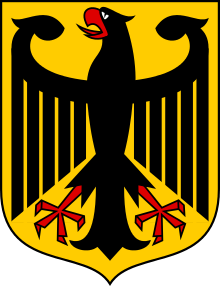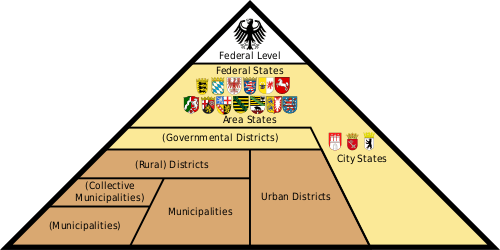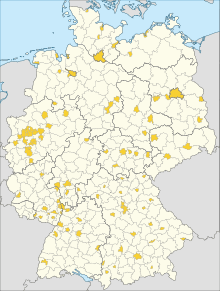Districts of Germany
In all German states, except for the three city states, the primary administrative subdivision higher than a Gemeinde (Municipality) is the Landkreis (official term in all but two states) or Kreis (official term in the states of North Rhine-Westphalia and Schleswig-Holstein).[1] Most major cities in Germany are not part of any Kreis, but instead cumulate the functions of a municipality and a Kreis; such a city is referred to as a Kreisfreie Stadt (literally "district-free city"; official term in all but one state) or Stadtkreis (literally "urban district"; official term in Baden-Württemberg).
| Look up Kreis in Wiktionary, the free dictionary. |
 |
|---|
| This article is part of a series on the politics and government of Germany |
|
|
Head of State |
|
Executive
|
|
|
Administrative divisions
|
|
(Land-)Kreise stand at an intermediate level of administration between each German state (Land, plural Länder) and the municipal governments (Gemeinde, plural Gemeinden) within it.[2] These correspond to level-3 administrative units in the Nomenclature of Territorial Units for Statistics (NUTS 3), and are roughly equivalent to counties in the United States.
Previously, the similar title Reichskreis (Imperial Circle) referred to groups of states in the Holy Roman Empire. The related term Landeskommissariat was used for similar administrative divisions in some German territories until the 19th century.
Types of districts

The majority of German districts are "rural districts"[3] (German: Landkreise), of which there are 294 as of 2017. Cities with more than 100,000 inhabitants (and smaller towns in some states) do not usually belong to a district, but take on district responsibilities themselves, similar to the concept of independent cities. These are known as "urban districts" (German: Kreisfreie Städte or Stadtkreise)—cities which constitute a district in their own right—and there are 107 of them,[4] bringing the total number of districts to 401. As of 2016, approximately 26 million people live in these 107 urban districts.[5]
In North Rhine-Westphalia, there are some cities with more than 100,000 inhabitants which are not urban districts, for example Recklinghausen, Siegen, Paderborn, Bergisch Gladbach, Neuss and Moers. Nevertheless, these cities take over many district responsibilities themselves, although they are still part of a larger rural district. Midsize towns can perform particular administrative functions of the district as well, especially to provide common services to the local citizens. The classification as "midsize" town is usually based on a town's registered population, but varies from state to state.
A special type of rural districts includes the three Kommunalverbände besonderer Art (Municipal unions of special kind), a fusion of a district-free town with its adjacent rural district: besides the Regionalverband Saarbrücken (Saarbrücken regional association), from 1974 until 2007 called "Stadtverband Saarbrücken" (Saarbrücken town association), there is the Hanover Region since 2001 and the Städteregion Aachen (Aachen region of towns) since 2009. Aachen, Hanover and Göttingen retain certain rights of an urban district (Kreisfreie Stadt); Saarbrücken has not explicitly determined a similar provision in its legislation.
Responsibilities

According to common federal and state laws, the districts are responsible for the following tasks:
- The building and upkeep of "district roads" (German: Kreisstraßen)
- Other building plans which cover more than one local authority's area
- Caring for national parks
- Social welfare
- Youth welfare
- The building and upkeep of hospitals
- The building and upkeep of state schools of secondary education
- Household waste collection and disposal
- Car registration
- Accommodation of foreign refugees
- Electing the Landrat or Landrätin, the chief executive and representative of the district
Districts can perform additional functions, based on varying local laws in each region:
- Financial support for culture
- The building of pedestrian zones and bicycle lanes
- Financial support for school exchanges
- The building and upkeep of public libraries
- Revitalisation of the economy
- Encouraging tourism
- The management of state-run adult education colleges (German: Volkshochschulen)
All these tasks are carried out by local (municipal) authorities operating together. Urban districts have these responsibilities and also those of the municipalities.
District council
The district council (German: Kreistag) is the highest institution of a rural district and is responsible for all fundamental guidelines of regional self-administration. This council is elected directly every five years, except in Bavaria where it is elected every six years. Usually the administrative seat of a rural district is located in one of its largest towns. However, district council and administrative seat of some rural districts are not situated within the district proper, but in an adjacent district-free city. Most of those rural districts are named after this central city as well (e.g. Bamberg and Karlsruhe). Moers is the biggest city in Germany (and at present time the only one with more than 100,000 inhabitants) that is neither an urban district, nor the district seat of its rural district.
District administration
The highest administrative position of a rural district is an officer known as Landrat or Landrätin, who is responsible for the district's day-to-day administration and acts as its representative for official purposes. In parts of northern Germany, Landrat is also the name of the entire district administration, which in southern Germany is known as Kreisverwaltung or Landratsamt.
In urban districts similar administrative functions are performed by a mayor, in most greater cities usually by the Lord Mayor.
Rural districts in some German states have an additional administrative committee called Kreisausschuss. This committee is generally led by the Landrat and includes a number of additional voluntary members. It takes over certain administrative functions for the district, following decisions of the district council. However, the exact role and regulations of this panel vary greatly between different states.
The city where the office of the district's administration is located is called Kreisstadt ("district city"), or Kreishauptort ("district main community") if it's not a city. Often the district is named after its district city.
Linguistically, any city within a district could be called a "Kreisstadt", especially those that aren't district-free to distinguish them from district-free cities. This term has to be distinguished from the legal term "Kreisstadt" that only denotes the location of the administrative office. In everyday language, district cities are also called Kreishauptstadt ("district capital").
See also
Notes
- In either case, the plural of the noun is formed by suffixing it with "e". In Germany, the term Kreis is also used informally for any rural district, and (for example in statistical summaries) for a district of any type.
- A Kreis is not to be confused with a Regierungsbezirk". These are state administrative subdivision above Landkreis-level and below state-level. Currently only four German 'Länder' (federal states) make use of this administrational level: North Rhine-Westphalia, Bavaria, Baden-Württemberg and Hesse.
- "Country Compendium, A companion to the English Style Guide" (PDF). European Commission Directorate-General for Translation (EC DGT). February 2017. pp. 50–51.
- This number includes the "city-states" of Berlin and Hamburg, and two urban districts of the city-state Bremen.
- "Kreisfreie Städte und Landkreise nach Fläche und Bevölkerung auf Grundlage des ZENSUS 2011 und Bevölkerungsdichte - Gebietsstand: 31.12.2015" (XLS) (in German). Statistisches Bundesamt Deutschland. July 2017. Retrieved 9 August 2017.